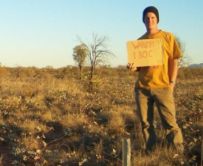Dr Boyd Wright
Lecturer in Botany , Fire Ecology - School of Environmental and Rural Science

Mobile: 0478 159 239
Email: bwright4@une.edu.au
Building: Eco-Physiology Lab in the Botany Building (S002
Biography
Boyd is a plant ecologist with a strong research focus on fire ecology and arid Australian ecosystems. He is particularly interested in how arid zone fires influence ecosystem processes and drive trait evolution in plants. In another life, he works as an interpreter and translator for Aboriginal tribal groups of west-central Australia and the Gibson Desert. With these people, he conducts research on ethnobotany, language and edible insects.
Qualifications
- 2011 Para-professional interpreter accreditation for the Pintupi-Luritja language with the National Accreditation Authority for Translators and Interpreters (NAATI). Interpreter ID: CPN9LM20V
- 2007 Doctor of Philosophy (Ecology), University of New England, Armidale, NSW. Thesis title: The fire ecology of the spinifex (Triodia spp.) hummock grasslands of Central Australia
- 2001 Bachelor of Science (Ecology) Hons (1st Class), University of Queensland, St Lucia, Qld. Thesis title: The ecological effects of fire on the Mitchell grasslands (Astrebla spp.) of western Queensland
- 2000 Bachelor of Australian Environmental Science, Griffith University, Brisbane, Qld.
Teaching Areas
- Ecology, Botany
Research Interests
- Fire ecology
- Mast seeding
- Seed bank ecology
- Ethnobotany
- Edible insects
Publications
Selected Publications
- Wright, B.R., Laffineur, B., Roye, D., Armstrong, G. and R.J. Fensham 2021. Rainfall-linked megafires as innate fire regime elements in arid Australian spinifex (Triodia spp.) grasslands. Frontiers in Ecology and Evolution doi: 10.3389/fevo.2021.666241
- Wright, B.R., Latz, P.K., Albrecht, D.A., R.J. Fensham 2020. Buffel grass (Cenchrus ciliaris) eradication in arid central Australia enhances native plant diversity and increases seed resources for granivores. Journal of Applied Vegetation Science. 24: e12533 DOI:10.1111/avsc.12533
- Nangala, J., Napangardi, Y., Napangardi, Y., B.R. Wright 2019. Ethnobotany of warrilyu (Eucalyptus pachyphylla F. Muell. [Myrtaceae]): Aboriginal seed food of the Gibson Desert, Western Australia. Economic Botany https://doi.org/10.1007/s12231-019-09471-2
- Wright, B.R. 2018. Evidence that shrublands and hummock grasslands are fire-mediated alternative stable states in the Australian Gibson Desert. Oecologia https://doi.org/10.1007/s00442-018-4215-2
- Wright, B.R., and R.J. Fensham. 2017. High-severity burning after strong mast years triggers mass recruitment of a fire-sensitive desert shrub. American Journal of Botany 104: 1474-1483
- Wright, B.R., and R. J. Fensham. 2016. Relationships between fire severity and recruitment in arid grassland dominated by the obligate-seeding soft spinifex (Triodia pungens). International Journal of Wildland Fire 25: 1264-1272
- Yen, A., M. Flavel, C. Bilney, L. Brown, S. Butler, K. Crossing, M. Jois, Y. Napaltjarri, Y. Napaltjarri, P. West, B.R. Wright. 2016. The bush coconut (scale insect gall) as food at Kiwirrkurra, Western Australia. Journal of Insects as Food and Feed 2: 293-299
- Wright, B.R., P.K. Latz and A.F. Zuur. 2016. Fire severity mediates seedling recruitment patterns in slender mulga (Acacia aptaneura), a fire-sensitive Australian desert shrub with heat-stimulated germination. Plant Ecology 217: 789-791
- Wright, B. R., A.F. Zuur, and G. Chan. 2014. Proximate causes and possible adaptive functions of mast seeding and barren flowers shows in spinifex grasses (Triodiaspp.) in arid regions of Australia. The Rangeland Journal 36: 297−308 (impact factor: 1.19)
- Wright, B. R., P. Mukhia and B. Tandin. 2014. The mast seeding plants of Bhutan. Proceedings of the Bhutan Ecological Society, 1, 23−32

